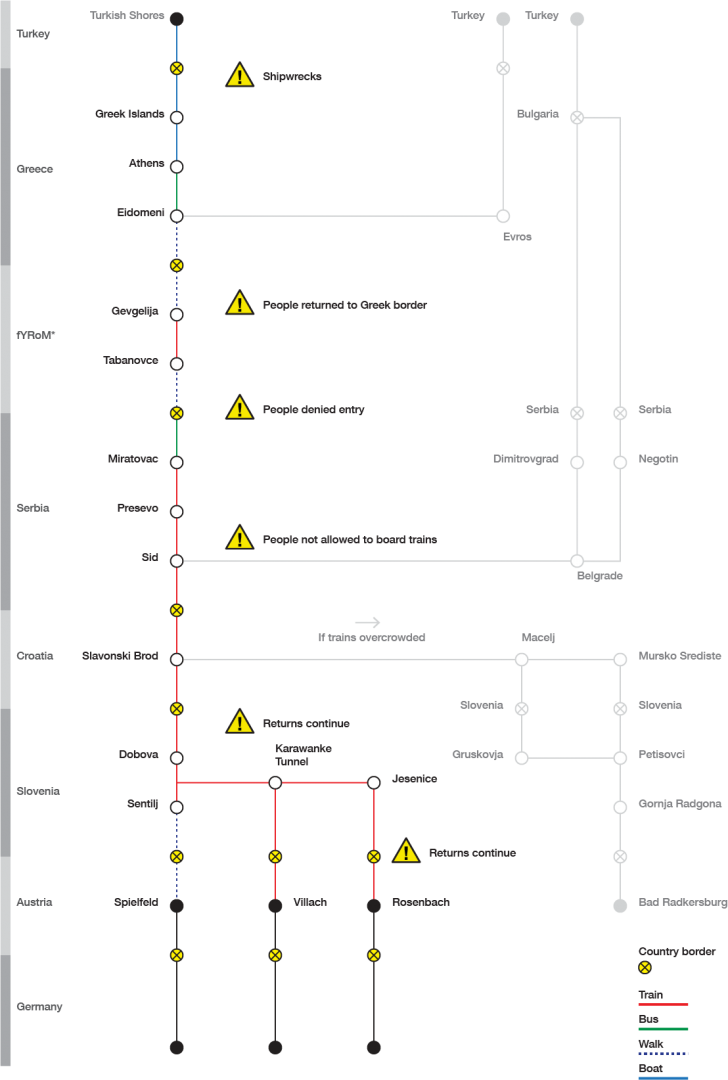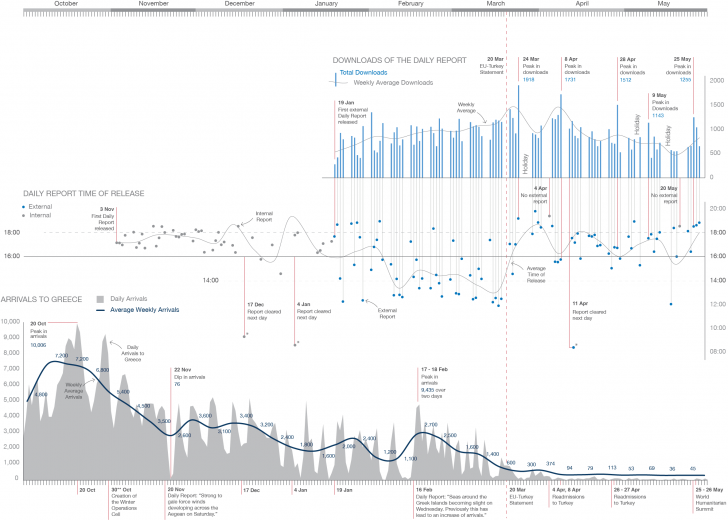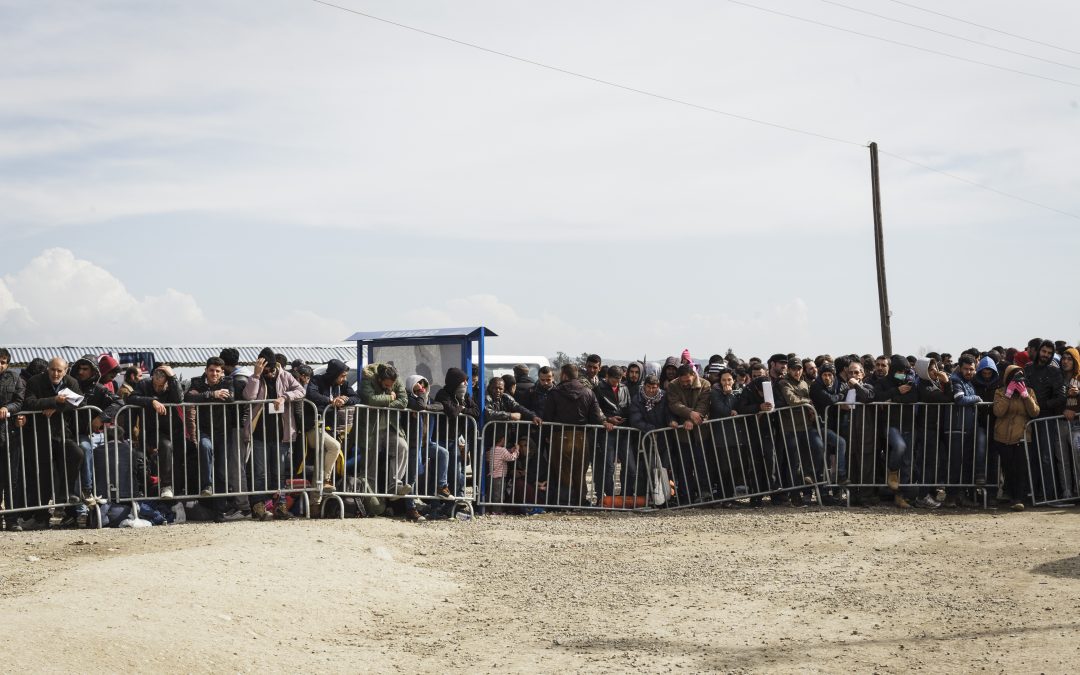This essay was originally posted in the recently released report: UNHCR Innovation Service: Year in Review 2016. This report highlights and showcases some of the innovative approaches the organization is taking to address complex refugee challenges and discover new opportunities. You can view the full microsite here.
A look back at UNHCR’s first ‘Winter Cell’
At the end of 2015, the UN Refugee Agency (UNHCR) was concerned that the “size, speed, and characteristics of the movements” of refugees, particularly approaching winter, may result in adverse consequences for refugees attempting to reach Europe from Turkey. In response to these challenges, a small interdisciplinary team, comprised of five people, was requested to form the Europe Winter Cell.
The Winter Cell was established on 28th October 2015 by the Assistant High Commissioner for Operations (AHC-O), at the request of former High Commissioner for Refugees, Antonio Guterres. The Winter Cell was established as a cross-cutting, inter-divisional response to the emergency situation in Europe and reported to the AHC-O and the Operations Manager for the Europe Refugee Crisis. The team was housed within the Emergency Operations Room in UNHCR’s Headquarters in Geneva.
As UNHCR advanced the Winter Cell’s objectives, its focus, resources and methods quickly evolved. Initially, the Winter Cell was intended to exist for a 4-month period before it was extended until the end of 2016 as the Intelligence and Analysis Unit as challenges and needs were identified beyond the initial period of the Cell, housed within the Regional Bureau for Europe. The team was eventually dismantled in June of 2016.
The importance of an interdisciplinary and non-linear team
One of the strengths of the Winter Cell was a non-linear structure to the team.
Non-linear team in this context means that the team is built based purely on deliverables, rather than ‘roles’ as we traditionally build teams. The main benefit of a non-linear team was the rapid delivery of services in areas where the team works in with several unknown variables, unpredictable outcomes and seemingly chaotic environments.
Team members being drawn from various UNHCR Divisions allowed for the incorporation of a wide range of expertise and easier organisational communication into the team. In turn, this led to further support in terms of technical expertise and tools.
An additional benefit of team members on loan from globally-oriented sections was to have access to the wider geographic spectrum of the European crisis extending from country of origin to country of destination.
The team remained adaptable, with all members supporting one another if and when others were redeployed to other pressing needs, either within Europe, or elsewhere. By the beginning of December, a core team remained, which comprised of the Head of Cell on loan from UNHCR’s Innovation Service, a Camp Coordination Camp Management (CCCM) Officer, an Information Management Officer, and a Designer, with close support from the Innovation Data Lab Manager who was loaned from Innovation when required.
Both the Information Management and the CCCM Officers, who work with data and camp management were considered essential for the principle running of the team, not only for the core competencies they possessed, as we were dealing with connecting heaps of data, data-based decision-making and on-site needs, but even more so for their aptitude, attitude, flexibility, and commitment. Additionally, invaluable interns joined the team over the course of 2016.
Once the Winter Cell was dismantled, the remaining team members, being multi-disciplinary, retained the scope as it was originally designed, however, as it was incorporated fully within the Europe Bureau, difficulties were experienced in maintaining the inter-departmental collaboration. An attempt was made to identify departmental focal points that the team would work through as required however, due to a lack of formally allocated responsibility, this did not prove consistently possible.
Approach
The team approached the objectives using tactics, innovation methodologies, and approaches drawn in part from lessons learned from the Innovation team:
Management structure
As a multi-disciplinary team, the team retained a relatively flat structure and was based on consensus and agreement, taking each individual’s core competencies as expert opinions. Broad parameters and directions were agreed upon. The Head of Cell found or created resources and consulted with senior management, providing the team with the space and tools required to meet the objectives of the Winter Cell.
Weekly lessons learned
As the Winter Cell was a new and unique practice for UNHCR, the Cell undertook the task of producing lessons learned on a weekly basis. This served two purposes: 1) to document decisions and mistakes made in order to save others time, should anything like the Winter Cell be reproduced or replicated in future; and 2) to provide the team a space in which to openly discuss issues/problems, but also the opportunity to express how things should or could change moving forwards, in order to constantly improve.
Prototyping and rapid iteration
The Winter Cell used low-fidelity prototyping to test concepts and assumptions to gain end-user feedback. As much was report-based, reports were prototyped with, among others, the AHC-O and other senior management, from the first day. Feedback was used to iterate products and processes. The team did not consider any product to be final but rather a new iteration, and always something to be improved. As the products began to be shared more widely, feedback surveys were incorporated into products, and a number of online tools were used to glean feedback from a wider range of consumers. The Winter Cell followed a simple innovation process that facilitated this adaptability:
Problem-setting/challenge definition;
Prototyping;
End-user feedback;
Iteration;
Finalisation, production.
Partnerships formed where no expertise exists in-house
Wherever a lack of expertise existed in-house, or within the team, the Winter Cell reached out strategically to external partners in order to seek out the right knowledge, products, skills, or services in order to meet the objectives of the Winter Cell, in the shortest timeframe possible. Over 20 potential partners were consulted and several experts were consulted in order to provide strategic advice to the team. These included inter alia Oxford University, FrontLine SMS, Grey Area Inc. consultancy, the UK Meteorological Office International Disaster Risk Reduction Programme, the UK Met Office Innovation team, the World Meteorological Organisation (WMO), the national Meteorological Services of Austria, Croatia, the former Yugoslav Republic of Macedonia, Greece, Serbia, Slovenia, Turkey, the International Maritime Organisation (IMO), the Assessment Capacities Project (ACAPS), and Microsoft.
Online collaboration tools
Within the team, online collaboration tools were used, including Google’ online tools, Slack, Dropbox, Asana, CartoDB, ArcGIS online, and Github. Slack was extended to the emergency at large. Whilst there was initial interest, active users remained at around 15 people. For members of the team, Slack was a success in reducing emails and retaining a high degree of collaboration, this, and other online tools, helped us to create and edit work collaboratively, and in real time. Benefits of collaborative and ‘open’ communication and work systems are not only about reducing the number of emails but that information is shared in ways that brings the culture of collaboration, ownership and recognition to effective levels.
Team reviews
Online tools were used to reduce email traffic and to increase efficiency. Due to the flat structure, the team also required spaces for collaboration and analysis. A daily review process was built into the team by way of a route map adapted from the London Tube map, in order to focus the various approaches and skills on the analysis that would be passed onto Senior Management. The map was used to identify potentially high-risk points between the Aegean Sea, and northern Europe.
Consultations and parameter setting
The team had regular consultations with the former High Commissioner, the AHC-O, the Director and Deputy Director of the Regional Bureau for Europe (RBE), the Deputy Directors of the Division of Emergencies Security and Supply, as well as the Director and Deputy Director of DPSM. These began on a daily basis, then as and when required, eventually with reduced consultation and guidance. The consultations were essential in outlining parameters, focus, and relevance.

One of the many UNHCR’s Winter Cell mappings
Why design was critical to the Winter Cell’s process
Design was used in a strategic manner to make a wealth of complicated and intertwined information and data as consumable as possible to a broader audience which included the Senior Management of UNHCR. Secondly, the incorporation of design thinking and processes served the efficiency and productivity of the team. UNHCR in the traditional sense, uses design to ‘make things pretty’, improving the layout of documents. In Winter Cell, design was used as a production method, and efficient work process where ‘design’ was both the driver and vehicle for content and messaging.

The Daily Progress Graph shows that the time of day reports were released had an impact upon the number of downloads – both unique and other – from the data.unhcr.org web portal.
Winter Cell Product Example
The Daily Progress Graph illustrates the distribution of products developed by the team over time. Two products were issued regularly throughout the duration of the team’s existence; the Daily Report and the Daily Email summarising the country reports. During the period of 30 October to 7 January, these were issued seven days a week, which along with an average of four Real-time Updates per day, marked a phase of continuous information collation and production.
The advent of weekly weather bulletins created in partnership with the UK Met Office in December supplemented the flow of information in support of the response to the emergency in Europe. In January and February, products related to social media monitoring were developed and tested, the content of which ultimately evolved into an addition to the daily report. Diverse products, including scenarios and other analysis products were developed by the team, including site profile overviews, winterisation reports, route analysis and alternative route scenarios, among many others. The variation in quantity of products is attributed to the number of staff assigned to the team, as well as the evolving contextual dynamics, compounded by a shift from an operational to an analytical focus.
Bringing predictive decision-making to UNHCR
The Winter Cell was geared towards facilitating proactive decision-making, rather than reactive. As the UK Met Office collaboration was in full swing, at the daily morning weather briefings, ideas were thrown around the team that lead to an insight of the ability to predict weather patterns against people flow. Expanding on this insight, the team drew together further data points into the mix, eventually resulting in the team creating a model that would give foresight on population flow trends to the Greek islands. This approach lead to the basis for what today is the effort to build population movement simulations in the Horn of Africa, by the Innovation Service
The Future
UNHCR’s Winter Cell, although short-lived, was one a successful effort to steer UNHCR towards a more data-driven organisation, where collection, analysis, and application of data was used in a proactive manner within an emergency.
It was also an opportunity for UNHCR to identify where the roadblocks are within the organisation to move quicker to meet the current and real time needs of refugees.

